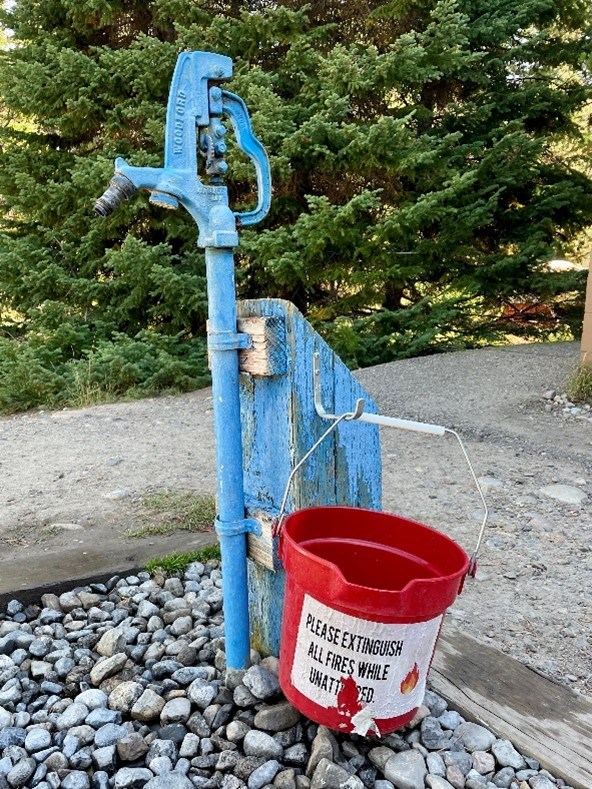Last updated: March 5, 2025
Article
Wildland Fire: Fire Buckets
Grand Teton National Park has a long history of wildfires. In 1974, Grand Teton was the site of one of the earliest naturally started fires that was allowed to burn in a national park. Wildfires that occur naturally benefit the ecosystem, but wildfires caused by human activity do not. The risk of wildfires at Grand Teton varies throughout the year but the risk increases when vegetation is dry, and temperatures are high. Approximately 150 abandoned fires are identified each year by the U.S. Forest Service in and around the park.
In 2021 alone, over 3.8 million people visited the park. Approximately 387,000 of those visitors stayed overnight in a concession campsite. Most individual campsites include a fire pit and campers can purchase IPM approved firewood. Firewood must be local to prevent the spread of invasive species like Asian long horned beetles and emerald ash borers. After enjoying their fire, campers are expected to douse the fire with water, keeping in mind that if the ashes are too hot to touch, it is too hot to leave.
Firewood Sales
It is important that visitors purchase firewood rather than bring their own into the park. To prevent the spread of invasive pests, park concessioners purchase and sell only locally grown and harvested firewood in accordance with state quarantines. The term “local firewood” often means purchasing firewood from within 50 miles from the source, even if it is within state lines.
Certified firewood must be bundled, and each bundle must contain a unique USDA issued certificate indicating it is pest-free. Concessioners must use string or binder twine to bundle firewood that can be safely burned in the fire. Outside of national parks, firewood is often wrapped in clear plastic that does not burn and is not environmentally friendly. Do not purchase firewood wrapped in clear plastic wrap which should not be burned.

Fire Buckets
To make fire extinguishing more accessible to visitors, the concessioners at Grand Teton came up with a simple but effective solution: buckets. At each campsite, visitors will find a three-gallon bucket on a hook next to the water spigot (pictured). The fire buckets give campers the opportunity to douse their fires before leaving the fire pit unattended. Abandoned fires are an ongoing issue for campground management. Although campsites are in areas cleared of flammable vegetation, the right conditions may cause a fire to spark. Unattended fires, even when small and contained, may ignite a rapidly spreading wildfire.
The fire buckets at Grand Teton were originally repurposed bulk food service buckets. While the food service buckets were functional, a standardized red bucket has been introduced for consistency across campgrounds in the park. The red buckets stand out and bring attention to the bucket. The buckets are labeled with their intended use and placed next to the water spigot for easy access.
Although the fire buckets have not mitigated all abandoned fires, campers are given the tools necessary to extinguish their fire whenever leaving the campsite. This small and easy-to-integrate solution to encourage campers to extinguish their fires has been successful. Visitors are consistently using the buckets to ensure their campfires are fully extinguished before leaving the site. Campground maintenance staff have seen a decrease in the number of abandoned fires.
Resources
To learn about Grand Teton’s history of wildland fire, visit nps.gov/grte. For more information on wildland fire safety, visit nps.gov/campfires. To find more information on state firewood policies and local quarantines, visit your state’s Department of Natural Resources (NDR) web pages or visit dontmovefirewood.org for state by state information. A Natural Resource Report, Reducing Ecological Risks Associated with Pests in Firewood summarizes current policies, regulations, and recommendations. It also provides examples of successful management efforts and references for technical assistance. For concessioner Wildland fire preparedness, visit the BottomLine News Update to read the Wildland Fire Series.
